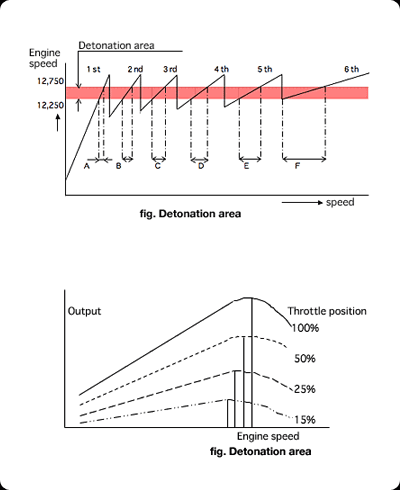| Detonation |
| |
Detonation will occur at before or after the maximum output speeds (if peak speed is 12500 rpm, detonation occurrence ranges from 12250 to 12750 rpm). Detonation seldom occurs outside these speed ranges. As shown below, 5th and 6th gears provide less acceleration than 1st and 2nd gears where there is extended use of these detonation range speeds. For this, circuits with more acceleration and deceleration frequencies give less detonation occurrence than circuits where there is extended use of wide open throttle operation using 5th and 6th gears. Frequent use of low ratio and 12750 rpm and over resulting from ratio choices will control propensity toward detonation. Also, distinct behavior of driving will result in less detonation associated with partial throttle opening. |
|
| |
|
|
| |

|
|
| |
|
|
| |
 |
 |
 |
 |
| In the engine output characteristics figure shown above, peak speed are changing, depending on wide open throttle to partial throttle. Accordingly, detonation occurrence ranges may vary with throttle opening. Detonation may suddenly take place when returning throttle from fully wide-open throttle at 11000 rpm. |
|
 |
 |
 |
 |
|
|
| |
|
|
| |
 |
 |
 |
 |
| Counting at fully wide open ranges tends to lead to damages, but counting at partial range will lead to less damages. Accordingly, you should find your base because counts are different from rider behaviors to course lay outs. |
|
 |
 |
 |
 |
|
|
| |
| Criteria for detonation counter |
| |
Many riders seem to have detonation counters fitted on their machines for information used for settings. Both the RS125R and RS250R should have detonation counter numbers of one to two per kilometer as criteria. In the case of the Suzuka Circuit with one lap length of about 6 kilometer, the criteria for the counter will be 12 per lap. As mentioned before, detonation will occur in needle ranges such as partial throttles as well as the fully open main region. You should check where values gained from the counters occur. One to two/km in the main region are recommended. |
|
| |
|
|
|
|
|
|
|